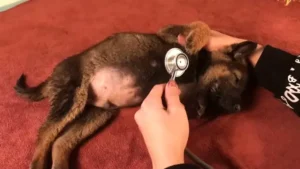In a tragic scene on a deserted highway, a tiny puppy, left behind by the side of the road, battled through freezing rain, desperately hoping for someone to save her.

Meet Nikki, a brave little soul who endured days of abandonment on a cold, rainy highway. The relentless rain soaked her frail body, leaving her shivering and in pain. Her weakened state was apparent as she curled up, trying to shield herself from the harsh elements.

Nikki was found by a kind-hearted passerby who couldn’t ignore her plight. Despite her fragile state, she was gently lifted into the safety of a car. Exhausted and barely able to move, Nikki let out soft, pained whimpers, a heartbreaking testament to her ordeal.

Now in the care of compassionate rescuers, Nikki is receiving the love and attention she so desperately needed. Though still weak, she showed signs of improvement the very next day—standing up for the first time and sipping a little milk. This tiny warrior is incredibly affectionate, and for the first time, she is sleeping in a warm, comfortable bed.

Nikki is thriving in the shelter, gaining weight, and looking more vibrant with each passing day. Her playful and loving nature is emerging, and she’s eagerly awaiting the day she’ll be adopted by a loving family who will cherish her forever.

Essential Guide: Keeping Your Dog Safe and Healthy in Extreme Cold Weather
To protect your furry friend during harsh winter conditions, follow these expert tips:
1. **Provide Proper Shelter**
– **Insulated Dog House:** Ensure your dog has a warm, insulated, and draft-free shelter. Elevate the dog house off the ground and add a door flap to block out wind and cold.
– **Indoor Comfort:** Whenever possible, bring your dog inside during extreme cold, especially at night.
2. **Dress Warmly**
– **Sweaters and Coats:** Equip your dog with a cozy, well-fitting sweater or coat. This is crucial for small, elderly, or short-haired breeds.
– **Protective Boots:** Use boots to safeguard your dog’s paws from ice, snow, and harmful salts. Ensure a comfortable fit to prevent any discomfort.
3. **Limit Outdoor Exposure**
– **Short Walks:** Keep outdoor time brief. Opt for short, frequent walks rather than long ones during freezing temperatures.
– **Supervise Play:** Monitor your dog during outdoor play and bring them inside if they start showing signs of cold, like shivering or lifting their paws off the ground.
4. **Monitor Your Dog’s Health**
– **Check for Frostbite:** Regularly inspect your dog’s paws, ears, and tail for frostbite signs such as pale or gray skin and blisters. Contact your vet immediately if you spot any symptoms.
– **Watch for Hypothermia:** Be alert for signs of hypothermia, including shivering, lethargy, and weakness. Severe cases can lead to unconsciousness, so seek veterinary care immediately if needed.
5. **Ensure Proper Nutrition**
– **High-Quality Diet:** Feed your dog a balanced, high-quality diet to maintain their energy levels in the cold.
– **Stay Hydrated:** Always provide fresh, unfrozen water.
6. **Grooming Care**
– **Dry Coat:** Keep your dog’s coat dry and well-groomed for better insulation.
– **Paw Care:** Trim the hair between your dog’s paw pads to prevent ice buildup.
7. **Create a Warm Indoor Environment**
– **Warm Bedding:** Offer warm, comfortable bedding in a draft-free area. Consider heated dog beds or add extra blankets for warmth.
– **Avoid Cold Floors:** Keep your dog’s sleeping area off cold surfaces like tile or concrete by using rugs or mats.
8. **Exercise Caution with Outdoor Hazards**
– **Avoid Antifreeze:** Keep antifreeze and other chemicals out of reach. Even a small amount can be fatal if ingested.
– **Clean Paws Post-Walk:** After walks, clean your dog’s paws to remove salt and de-icers, which can irritate their skin.
9. **Regular Vet Visits**
– **Health Checkups:** Schedule regular vet visits to monitor your dog’s health, addressing any issues that could make them more susceptible to cold.
By following these guidelines, you can keep your dog safe, healthy, and comfortable during the cold winter months. Always be attentive to your dog’s behavior and adjust their care as needed to ensure their well-being in extreme weather.
